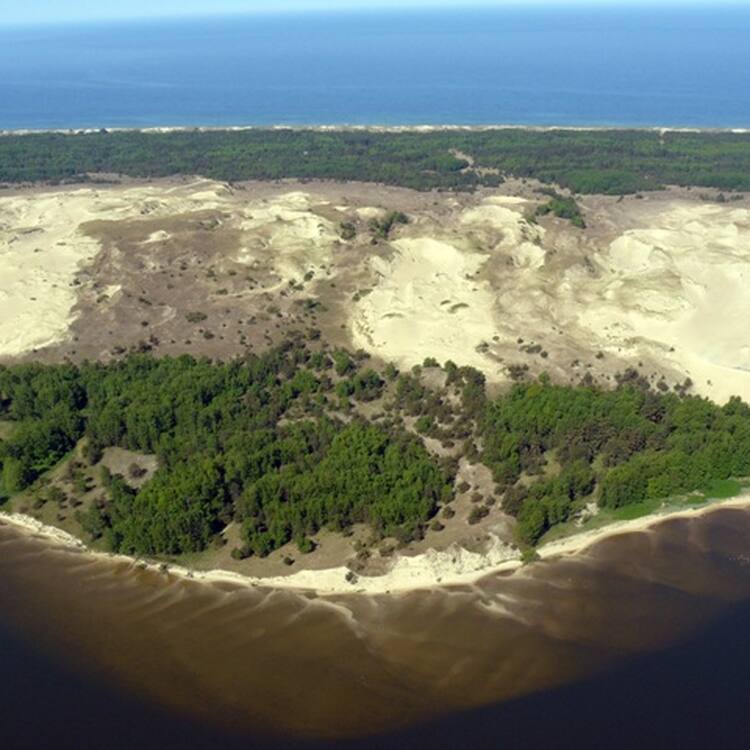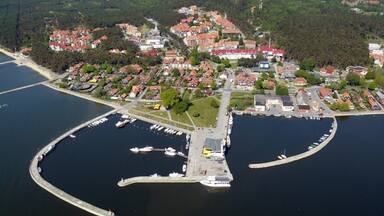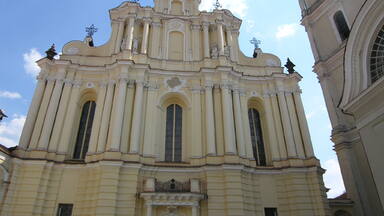Curonian Spit
Curonian Spit
Human habitation of this elongated sand dune peninsula, 98 km long and 0.4-4 km wide, dates back to prehistoric times. Throughout this period it has been threatened by the natural forces of wind and waves. Its survival to the present day has been made possible only as a result of ceaseless human efforts to combat the erosion of the Spit, dramatically illustrated by continuing stabilisation and reforestation projects.
Description is available under license CC-BY-SA IGO 3.0
Isthme de Courlande
L'occupation humaine de cette étroite péninsule de dunes de sable, longue de 98 km et large de 0,4 à 4 km, remonte aux temps préhistoriques. Depuis cette période, elle a été sous la menace des forces naturelles du vent et des vagues. Elle ne doit sa préservation actuelle qu'aux efforts incessants des habitants pour combattre l'érosion de l'isthme, efforts remarquablement illustrés par les projets continus de stabilisation et de reboisement.
Description is available under license CC-BY-SA IGO 3.0
برزخ كورلاند
يرقى الوجود البشري في شبه الجزيرة الضيّقة هذه المكوّنة من كثبان الرمل على طول 98 كيلومترا وعرض 0.4 إلى 4 أمتار إلى حقبة ما قبل التاريخ وهي تعرّضت مذ ذاك لأهواء الطبيعة من هواء وأمواج. وهي تدين بوضعها الحالي لجهود السكان المتتابعة لمكافحة تعرية البرزخ وهي جهود جسّدتها مشاريع مستمّرة لإرساء الاستقرار وإعادة التشجير.
source: UNESCO/CPE
Description is available under license CC-BY-SA IGO 3.0
库尔斯沙嘴
这个延伸出来的沙丘半岛长98公里,宽0.4-4公里,史前时代就有人类居住。自古以来,这里受到了海风、潮汐等自然力量的威胁,由于一代又一代的人通过不断的造林固沙工程与沙嘴的侵蚀进行搏斗,使遗址如今得以存在。
source: UNESCO/CPE
Description is available under license CC-BY-SA IGO 3.0
Куршская коса
Освоение человеком этого узкого песчаного полуострова, имеющего протяженность 98 км и ширину от 400 м до 4 км, началось еще в доисторические времена. Коса подвергалась также воздействию природных сил – ветра и морских волн. Сохранение этого уникального культурного ландшафта до наших дней стало возможным только благодаря непрекращающейся борьбе человека с процессами эрозии (закрепление дюн, лесопосадки).
source: UNESCO/CPE
Description is available under license CC-BY-SA IGO 3.0
Istmo de Curlandia
La ocupación humana de esta estrecha península de dunas de arena –de 98 km. de largo y 0,4 a 4 km de ancho– data de los tiempos prehistóricos. Sometido a los continuos embates del viento y las olas, el istmo debe su estado de conservación actual a los denodados esfuerzos realizados por sus habitantes para contrarrestar la erosión. Esta labor incesante la ilustran los continuos proyectos de estabilización y repoblación forestal que se llevan a cabo.
source: UNESCO/CPE
Description is available under license CC-BY-SA IGO 3.0
クルシュー砂州
source: NFUAJ
Koerse Schoorwal
Source: unesco.nl
Outstanding Universal Value
Brief synthesis
The Curonian Spit is a unique and vulnerable, sandy and wooded cultural landscape on a coastal spit which features small Curonian lagoon settlements. The Spit was formed by the sea, wind and human activity and continues to be shaped by them. Rich with an abundance of unique natural and cultural features, it has retained its social and cultural importance. Local communities adapted to the changes in the natural environment in order to survive. This interaction between humans and nature shaped the Curonian Spit cultural landscape.
The history of the Curonian Spit is dramatic: 5,000 years ago, a narrow peninsula (98 km in length and 0.4-3.8 km in width), the Great Dune Ridge separating the Baltic Sea from the Curonian Lagoon, was formed on moraine islands from sand transported by currents, and later covered by forest. After intensive logging in the 17th and 18th centuries, the dunes began moving towards the Curonian Lagoon, burying the oldest settlements. At the turn of the 19th century, it became evident that human habitation would no longer be possible in the area without immediate action. Dune stabilisation work began, and has continued ever since. By the end of the 19th century, a protective dune ridge was formed along the seashore to prevent inland sand migration, and the Great Dune Ridge was reinforced using trees and brushwood hedges. Currently, forests and sands dominate the Curonian Spit. Urbanised areas (eight small settlements) cover just about 6% of the land.
The most valuable elements and qualities of the Curonian Spit cultural landscape are its unique size and general spatial structure, demonstrating the harmonious coexistence between humans and nature; the characteristic panoramas and the silhouette of the Curonian lagoon; cultural elements including the remains of postal tracks, trade villages from the 10th and 11th centuries, traditional fishermen villages and other archaeological heritage covered by sand; the spatial-planned structure and architecture of ancient fishermen villages turned into resort settlements (ancient wooden fishermen houses, professionally designed buildings of the 19th century, including lighthouses, piers, churches, schools, villas); and elements of marine cultural heritage; natural and human-made elements including the distinctive Great Dune Ridge and individual dunes, relics of ancient parabolic dunes; a human-made protective coastal dune ridge; relics of moraine islands, seacoast and littoral forests and littoral capes; ancient forests, mountain pine forests and other unique sand flora and fauna including a bird migration path; and the social-cultural traditions, spirituality, and the social perception of the area, which reflect the local lifestyle formerly centred on fishermen, artists, scientists, yachtsmen and gliders, travellers and other visitors.
Criterion (v): The Curonian Spit is an outstanding example of a landscape of sand dunes that is under constant threat from natural forces (wind and tide). After disastrous human interventions that menaced its survival, the Spit was reclaimed by massive protection and stabilization works that began in the 19th century and are still continuing to the present day.
Integrity
The entire area of the Curonian Spit cultural landscape reflects valuable qualities and underlying processes, retains historical functions and specific sustainable land use methods related to the peculiarities of the natural environment, and reflects the unique spiritual bond between humans and nature. The boundaries of the World Heritage property are sufficient to express all the attributes of its Outstanding Universal Value. Some of these attributes, such as the fishermen houses, need careful maintenance. In general, these attributes are particularly sensitive to pressures such as climate change, severe weather events, fire, excessive development and tourism. Because of the continuous evolution and development of the cultural landscape, it is very important to regulate the number of visitors to the property. New developments and other economic activities must be regulated to avoid any irreversible changes that may threaten the Outstanding Universal Value. The most vulnerable elements of the Curonian Spit cultural landscape are the oldest wooden fishermen’s houses, the wooden decor of professionally designed buildings, and the human-made protective coastal dune ridge, which is influenced by the natural coastal processes under the influence of global climate change.
Authenticity
The Curonian Spit showcases high landscape values. It is an example of a special landform subjected to human intervention and natural phenomena such as climatic variations. The former has been both catastrophic, as with the drastic deforestation in the 16th century, and beneficial, as demonstrated in the 19th century with the creation of artificial barriers against further incursions by the sea. The cultural, natural and human-made elements of the Curonian Spit cultural landscape illustrate the most important features of its formation through their shapes, volumes, materials, and functions. The authenticity of the landscape is reflected by the tangible and spiritual values of the different historical periods that shaped its identity.
The vitality, spirituality and special mood of the cultural landscape and its unique characteristics is further highlighted by authentic forms of local intangible heritage. These include the marine cultural heritage; traditional trades, folklore and artistic traditions; the ethnographic elements of the fishermen’s lifestyles; unique methods of protective coast and dune ridge management and forest maintenance; sustainable recreational activities and a cultural leisure tradition dating back to the 19th century.
Protection and management requirements
The Curonian Spit is situated in the Curonian Spit National Park in Lithuania and the Kurshskaya National Park of the Russian Federation. The status of these National Parks guarantees the protection of the cultural landscape. Both National Parks have the common goal of preserving the natural and cultural attributes that express the Outstanding Universal Value of the property. A very important prerequisite for the protection of the Outstanding Universal Value is state land ownership by the National Parks.
The governments of both states are responsible for the conservation of the Curonian Spit: in the Republic of Lithuania through the Ministry of Environment and authorised agencies, and in the Russian Federation through the Ministry of Natural Resources and Environment. The protection of immovable cultural heritage is the responsibility of the cultural Heritage Department under the Ministry of Culture of the Republic of Lithuania and the State Service for Protection of cultural Heritage of the Kaliningrad region of the Russian Federation. The Governments have created the National Parks authorities, who play a key role in the conservation of the property, forest and coastal management.
The territory of the Curonian Spit is administered by Neringa and Klaipėda City municipalities of the Republic of Lithuania and by the Federal State corporation National Park Kurshskaja kosa, along with the municipal unit of Kurshskaja kosa of the Zelenogradsk area of the Kaliningrad region of the Russian Federation. The local authorities in the Republic of Lithuania determine the main trends of socio-economic development, manage and plan settlements, and generally take care of the protection and management of the territory by implementing territorial planning documents in the Lithuanian part of the Curonian Spit. The local community is directly involved in the conservation of the property’s tangible heritage and also carries the region’s intangible heritage.
For the effective management and protection of the property’s Outstanding Universal Value, closer collaboration of all institutions and stakeholders is needed within and between States.
In the Republic of Lithuania, any activity posing a threat to the Outstanding Universal Value of the Curonian Spit is prohibited by the Law on Protected Areas (2001), and Protection Regulation of the Curonian Spit National Park (2002). In the Russian Federation, the relevant laws are the Federal Law of Specially Protected Nature Territories of the Russian Federation (1995) and the Law on Federal State Enterprise (FSBA, 2012), implemented through territorial planning documents.
Different attributes of the property require different protection regimes and management activities. Therefore, different zones have been established in the National Parks for various specific purposes, such as strict reserves, reserves, recreational, residential and other zones. All these measures are outlined in the territorial planning documents.
The main territorial planning documents in the Republic of Lithuania are the Special Management Plan of the Curonian Spit (a territorial planning document adopted by the government in 2012), and the National Park Borders Plan (adopted by Parliament in 2010). Klaipėda’s municipal General Plan has been in place since 2007, while Neringa’s General Plan was adopted by the municipality in 2012.
The preparation of a single territorial planning document for the management of the area, aiming to ensure the preservation of the property’s Outstanding Universal Value in Lithuania is foreseen. The main territorial planning document in the Russian Federation is the Development Plan for the National Park Kurshskaja Kosa for 2009-2013.
The coordination of actions between the States is necessary to protect the Outstanding Universal Value of the property. Once finalised and agreed upon, an integrated Curonian Spit Management Plan covering the whole property will be implemented in order to ensure the conservation of the Outstanding Universal Value, to improve cooperation between all institutions in both States, and to reach joint agreements on future activities. The preparation of this Management Plan is an essential step in the appropriate management of the property and particular attention should be paid to including a Tourism Management Plan and addressing the other major pressures potentially affecting the property. The implementation of territorial planning documents and the safeguarding of the implementation of existing legislation are high priorities.
Links
-
Directorate of the Kuršių nerija National park
-
Curonian Spit National Park
-
Natural Heritage Protection Fund
-
Commission of the Russian Federation for UNESCO
-
Commission of the Russian Federation for UNESCO
-
Lithuanian National Commission for UNESCO
-
Greenpeace Russia
-
Kursiu Nerija National Park (in Russian)





